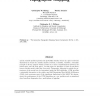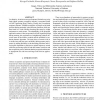64 search results - page 1 / 13 » Learning Multiple Latent Variables with Self-Organizing Maps |
GRC
2010
IEEE
13 years 8 months ago
2010
IEEE
Inference of latent variables from complicated data is one important problem in data mining. The high dimensionality and high complexity of real world data often make accurate infe...
NECO
1998
13 years 6 months ago
1998
Latent variable models represent the probability density of data in a space of several dimensions in terms of a smaller number of latent, or hidden, variables. A familiar example ...
ICPR
2010
IEEE
13 years 4 months ago
2010
IEEE
Detecting abnormal behaviors in crowd scenes is quite important for public security and has been paid more and more attentions. Most previous methods use offline trained model to p...
CIBCB
2005
IEEE
14 years 17 days ago
2005
IEEE
- Establishing structure-function relationships on the proteomic scale is a unique challenge faced by bioinformatics and molecular biosciences. Large protein families represent nat...
WIAMIS
2009
IEEE
14 years 1 months ago
2009
IEEE
An adaptive, invariant to user performance fluctuation or noisy input signal, gesture recognition scheme is presented based on Self Organizing Maps, Markov Models and Levenshtein...


